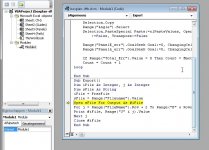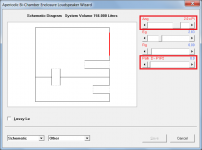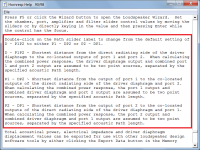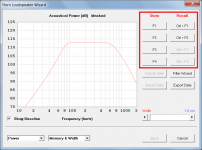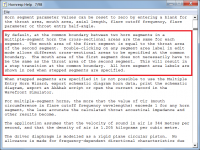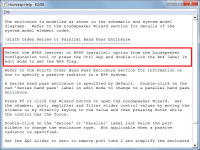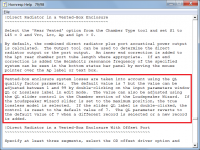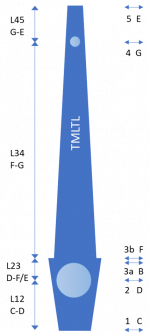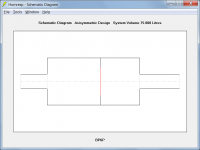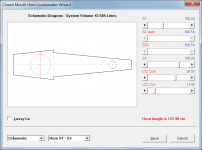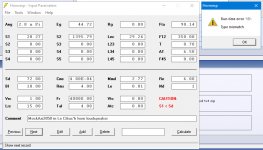Another comparison that might be of interest - this time it's a design sim'd as a series-tuned BP system and then as a TH. The differences are not as pronounced as my last comparison, but they're still there. Fb in the BP sim is a few Hz lower than that of the TH sim.
So, which one is "more correct"
The workbook is BOXPLAN-BP6S2 v 0.3 beta, available from my site The Subwoofer DIY Page - Horn Folding
Hi there
That is nice software.
I have download a file for calculation but get a error with it's visual basic, it remember this was also with a exel for resonant smps amybe something is not installed here. I use windows7.
For calculation of a band pass subwoofer can David tell me how? did see in other that it is in tab where to choose system like TH, OD etc. There was also BP but is this gone?
regards
regards
Attachments
Last edited:
How much power are you hoping to pour into this little woofer?
It only has a 25mm or 1 inch voice coil. And the wire gauge will be nearly tweeter thickness to keep up the motor force. 30 watt peaks for a brief time only. Remember that even at the very wishful efficiency rating this driver is almost 95% inefficient. Which means almost all the power going into the driver will get turned into heat!
Other wise.
You have a really flat back loaded horn. But huge!
Are you hoping that the rear wall and or corner will augment what you have worked out?
Thanks for the incredibly helpful feedback, Mark! I know very little about how to evaluate drivers beyond some, only some, of the T/S parameters, so your comment on the motor properties is eye-opening for me. I'm not wedded to a specific driver, so that's something to noodle on some more.
Yes, I was planning on exploiting a rear wall to get the bass response down to ~40Hz. When I embarked on this, I had a design that was pretty close in the main cabinet size (i.e., excluding the rear "wing"/ bell of the BLH) to the commercial tower speakers I currently own, but it's Fc was 100Hz, down to maybe ~50Hz with the rear boundary. I'm ambivalent about making something substantially larger for only 10 HZ more, especially for the first speakers I've ever designed/built.
Okay, now I recognize the project.Not exactly, Neil, but attached is something close--the out-of-date design. I've been making so many modeling changes, I decided to stop trying to keep up with the physical design until I could converge on a good schematic. The attached is the side view of the basic format though. Key differences:
- The BLH won't have an offset driver.
- The FLH has a small rear chamber
- And the BLH will expand linearly (conical), not exponentially.
I'll likely have to fold the horn differently, though, with the driver nearer the top of the cabinet.
Hope this helps--LMK.
I wonder if there is a way to have the closed end above and behind the driver, and then have the open end go downward, so that you can use the space that is a void, for the horn instead? If more length is needed, it could turn up and then have the opening up behind the driver, possibly. Having the flare on the back of a box, seems to not make efficient use of all the construction.
Okay, now I recognize the project.
I wonder if there is a way to have the closed end above and behind the driver, and then have the open end go downward, so that you can use the space that is a void, for the horn instead? If more length is needed, it could turn up and then have the opening up behind the driver, possibly. Having the flare on the back of a box, seems to not make efficient use of all the construction.
Thanks Neil. It's definitely a puzzle to be solved. When this design was configured as an offset driver, that void was very handy, because it provided complete freedom to manage the size of the coupling chamber and the offset. However, it turned out what I really needed was a very small coupling chamber anyway, smaller than an offset driver config could support. So now the void is just a void. I agree with you that making better use of the rectilinear part of the cabinet is a higher priority.
My aesthetic goal was to make the "cabinet proper"--the rectilinear box part--not far from the size of the towers I have currently, and then the wing-like flare out the back, which looks kinda cool (to me anyway), occupies space in the room not otherwise used. I've just started thinking about going back to a smaller box and also making a sub, because, well, that'd be fun too.
I'm close to updating the physical design, so I'll post it when it's finished...
Last edited:
Could someone help me understand why the QL quality factor setting only applies to a vented enclosure in hornresp?
I understand its to do with the real world losses and gives a more realistic prediction, most notably how xmax doesn't drop to zero at tuning anymore which results in less output and lower port velocity, exactly how we see in the real world
But where i'm confused is why it doesn't apply to horns or in the bandpass wizard, they both have the large spike in output and the zero xmax at tuning which obviously isn't how they're going to actually perform
Is there a way to add the losses to horns/bandpass enclosures that i'm not seeing? if hornresp doesn't have this option is it something we could expect to be added one day?
maybe i'm looking at this all wrong but having losses on horns/bandpass enclosures would give us much more realistic predictions like with the vented enclosures
I ask all this because i'm wanting to build a vented enclosure and a transmission line enclosure with as close of a predicted output as possible to compare against each other, but with one being calculated with losses and the other lossless i'm finding it quite difficult
I understand its to do with the real world losses and gives a more realistic prediction, most notably how xmax doesn't drop to zero at tuning anymore which results in less output and lower port velocity, exactly how we see in the real world
But where i'm confused is why it doesn't apply to horns or in the bandpass wizard, they both have the large spike in output and the zero xmax at tuning which obviously isn't how they're going to actually perform
Is there a way to add the losses to horns/bandpass enclosures that i'm not seeing? if hornresp doesn't have this option is it something we could expect to be added one day?
maybe i'm looking at this all wrong but having losses on horns/bandpass enclosures would give us much more realistic predictions like with the vented enclosures
I ask all this because i'm wanting to build a vented enclosure and a transmission line enclosure with as close of a predicted output as possible to compare against each other, but with one being calculated with losses and the other lossless i'm finding it quite difficult
Hi there
That is nice software.
I have download a file for calculation but get a error with it's visual basic, it remember this was also with a exel for resonant smps amybe something is not installed here. I use windows7.
Please use the following thread for assistance with the BOXPLAN workbooks. David's "Hornresp" thread is long enough...
Spreadsheet for Folded Horn Layouts...
Hornresp Update 5130-210115
Hi Everyone,
CHANGE 1
Ang and Path sliders have been added to the band pass wizard. Ang applies to all models, Path applies to BP6P, BPA, BPC, DBR and ABC models.
ABC has three path options (D - P1P2, P1 - DP2 and P2 - DP1). See the Help file for further details.
CHANGE 2
Stepped segment system files exported from BOXPLAN can now be imported into Hornresp.
CHANGE 3
It is no longer possible to open renamed copies of the Hornresp.exe file. This prevents multiple instances of the program from being run and causing data to be lost.
BUG FIX
If a change was made on the main Input Parameters window and the loudspeaker wizard then opened and the Cancel button clicked, the 'Save changes to current record' prompt would not appear when the record was closed, and the change would not be saved. This has now been fixed.
My thanks to 1hiep0 for reporting the problem.
Kind regards,
David
Hi Everyone,
CHANGE 1
Ang and Path sliders have been added to the band pass wizard. Ang applies to all models, Path applies to BP6P, BPA, BPC, DBR and ABC models.
ABC has three path options (D - P1P2, P1 - DP2 and P2 - DP1). See the Help file for further details.
CHANGE 2
Stepped segment system files exported from BOXPLAN can now be imported into Hornresp.
CHANGE 3
It is no longer possible to open renamed copies of the Hornresp.exe file. This prevents multiple instances of the program from being run and causing data to be lost.
BUG FIX
If a change was made on the main Input Parameters window and the loudspeaker wizard then opened and the Cancel button clicked, the 'Save changes to current record' prompt would not appear when the record was closed, and the change would not be saved. This has now been fixed.
My thanks to 1hiep0 for reporting the problem.
Kind regards,
David
Attachments
I do that sometimes, but only to be able to do a quick side by side comparison of the effects of some change in design.
If working in the Loudspeaker Wizard, up to four different sets of results can be temporarily stored and recalled for comparison purposes by pressing key F1 to F4 to store, and keys Ctrl+F1 to Ctrl+F4 to recall.
Attachments
Hornresp doesnt handle the stepped design into a tapered line
Have you tried using the stepped segment option?
Attachments
For calculation of a band pass subwoofer can David tell me how?
It's in the Help file...
Attachments
with one being calculated with losses and the other lossless i'm finding it quite difficult
For comparison purposes, simply set QL to Lossless...
Attachments
For comparison purposes, simply set QL to Lossless...
Sure, that would work in this specific scenario, but what about when just building a horn or bandpass enclosure in general? they don't appear to have any compression losses in the prediction, leading to much higher peaks in the response and extremely high port velocity
they don't appear to have any compression losses in the prediction
The QL quality factor parameter used in Hornresp only applies to standard bass-reflex type enclosures (see the post linked below for further information). As indicated in the Help file, system transmission losses are otherwise assumed to be zero. I suspect that it would not be an easy task to accurately predict horn loudspeaker internal losses. The best that Hornresp can do in this regard is to allow the user to specify absorbent filling material in the horn segments, and to observe the effect on the results.
https://www.diyaudio.com/forums/subwoofers/119854-hornresp-1100.html#post6308267
Have you tried using the stepped segment option?
Yes, but it only cater for straight/cylindrical segments. It can´t really cater what I like to build. See picture below. The stepped cylindrical approach has a quite different spl result from my design.
Attachments
Hi,
is it possible to simulate a 6th order parallel bandpass with pipes instead of helmholtz resonator chambers in hornresp?
I think that would be a combination of "Loudspeaker Wizard"->"Power"->"Output1" of two transmissionlines with one driver connecting them.
Thanks!
is it possible to simulate a 6th order parallel bandpass with pipes instead of helmholtz resonator chambers in hornresp?
I think that would be a combination of "Loudspeaker Wizard"->"Power"->"Output1" of two transmissionlines with one driver connecting them.
Thanks!
is it possible to simulate a 6th order parallel bandpass with pipes instead of helmholtz resonator chambers in hornresp?
By "pipes", I assume that you mean segments?
If so, then a BP6P system can be modelled as a compound horn (CH).
Attachments
Runtime Error 13 on certain sims after update?
Do you have a specific design that generates the error, that I could use for testing purposes?
but it only cater for straight/cylindrical segments.
???
Attachments
- Home
- Loudspeakers
- Subwoofers
- Hornresp
